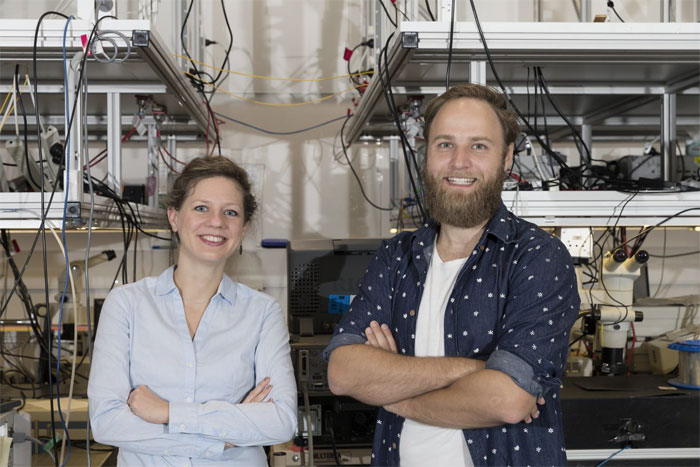
Converting Light to Sound Waves Leads to Hybrid Chip for Data Transfer
Researchers have demonstrated a way to transfer optical information coherently to an acoustic hypersound wave on a photonic microchip. Optical information is extracted using a reverse process. A coherent buffer can store the photonic information in a sound wave for later retrieval.
Hypersound waves, or phonons, have wavelengths similar to optical photons, but travel at five orders of magnitude lower velocity. This delay allows for the data to be briefly stored and managed inside the chip for processing, retrieval and further transmission.
While light is an excellent carrier of information over long distances, the ability to store or delay optical signals is needed to maintain the coherence of the optical signal. Coupling light to coherent acoustic phonons in optomechanical systems such as this one allows the velocity of an optical pulse to be slowed down, and enables a full transfer of an optical wave to an acoustic wave, which subsequently can be transferred back to the optical domain after time in storage.
The research team from the University of Sydney further demonstrated the storage of optical information with gigahertz bandwidth. They showed that the phase-matching condition between traveling acoustic and optical waves could allow for unambiguous storage and retrieval at several different wavelengths, with negligible crosstalk.

Researchers Birgit Stiller (left) and Moritz Merklein in their laboratory in the University of Sydney Nanoscience Hub. Courtesy of Louise Connor/University of Sydney.
“Our system is not limited to a narrow bandwidth. So unlike previous systems, this allows us to store and retrieve information at multiple wavelengths simultaneously, vastly increasing the efficiency of the device,” said researcher Birgit Stiller.
The photonic-phononic memory is fully controlled by the spatial-temporal overlap of the data, write and read optical pulses in a simple planar photonic circuit. The buffer is not an additional element of the circuit, and the photonic waveguide/link itself can be used as the buffering element.
The versatility of the device's memory, plus the continuous tunability of the storage time of up to several nanoseconds, could enable precise, dynamic synchronization of optical data streams among several high-speed parallel processes.
The ability to transfer information from the optical to acoustic domain and back again inside a chip could further the development of photonic integrated circuits. These hybrid chips are targeted for use in telecommunications, optical fiber networks and cloud computing data centers, where traditional electronic devices are susceptible to electromagnetic interference, can produce too much heat or use too much energy.
“This is an important step forward in the field of optical information processing as this concept fulfills all requirements for current and future-generation optical communication systems,” professor Benjamin Eggleton said.
The research was published in Nature Communications (doi: 10.1038/s41467-017-00717-y).
This is a stylized explanation of how the chip works. 1. Photonic (light) data pulse (yellow) enters from the left. 2. A 'write pulse' (blue) enters from the right. 3. The data and write pulses interact in the chip, producing an acoustic wave, storing the data and allowing for processing, retrieval and further transmission. 4. Another photonic read pulse (blue) enters the chip, accessing the acoustic data and transmitting the data as photonic information (yellow) to the right side of the microchip. 5. Light passes through the chip in two to three nanoseconds, depending on the length of the spiral on the chip. Information can be held on the chip for an extra 10 nanoseconds as acoustic data. Courtesy of Rhys Holland & Sebastian Zentilomo/University of Sydney.
Published: September 2017